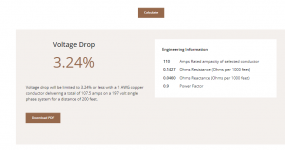zemingduan
Senior Member
- Location
- Philadelphia,PA
- Occupation
- Electrical Designer
First, I want clarify that I am not asking how to calculate the voltage drop. I know how to calculate the voltage drop per NEC and I use this calculator by Soutwire to calculate the voltage drop (https://www.southwire.com/calculator-vdrop). But I want to know how many amps I shall use when calculate the voltage drop and consider the effect of the voltage drop on conductors size. This problem bother me for a long time.
For example, a 830 sqft apartment unit with 4.5kva water heater, 1.5kva washer, 5kva dryer, 8kva range, 1kva dishwasher, 1kva fridge, 1.5kva microwave/hood, 0.8kva garbage disposal, 2.5kva heat pump outdoor condenser(12A @208V), 1.2kva air handler unit (5.8A @208V) with 3.6kva@208V electric heating kit, the calculated load per NEC 220. 82 is: ((0.83*3+4.5+1.5+5+8+1+1+1.5+0.8)-10)*0.4+10+2.5+1.2+3.6*0.65 kva = 22.356 kva. The calculated amps @208V is 22.356kva/208V = 107.5A. A 125A feeder is required. The apartment feeder is 200'. When you size the minimum conductor size to obtain the 3% voltage drop or estimate the voltage drop based on #1 cooper wire, do you use 107.5A calculated per NEC 220.82? But I think NEC calculated load is always larger than in reality. Is it overkill to use this amps to estimate/consider the voltage drop on the apartment feeder?
The NEC 310.75(B)(7) states the ampacity of the feeder/service doesn't need to exceed 83% of the feeder rating which is 125A *0.83 = 103.75A. So what about using 103.75A to calculate the voltage drop? But is it still overkill?
Do you use an experienced number? How do you consider the voltage drop?
What about considering the voltage drop on the service conductors that supply a multifamily dwelling building? For example the calculated load of (55) above dwelling units is around 1200A @ 208V 3phase per NEC 220.84. The service conductors in conduit under ground that go to the meter bank is 450'. I have a project that the meter bank is 440' away from the utility pad mount transformer with under ground conductors... The largest run of a unit feeder is 200' from the meter bank to unit load center. How do you consider the voltage drop? What size of cooper conductors and how many sets will you use that takes the voltage drop into account?
Thank you!
For example, a 830 sqft apartment unit with 4.5kva water heater, 1.5kva washer, 5kva dryer, 8kva range, 1kva dishwasher, 1kva fridge, 1.5kva microwave/hood, 0.8kva garbage disposal, 2.5kva heat pump outdoor condenser(12A @208V), 1.2kva air handler unit (5.8A @208V) with 3.6kva@208V electric heating kit, the calculated load per NEC 220. 82 is: ((0.83*3+4.5+1.5+5+8+1+1+1.5+0.8)-10)*0.4+10+2.5+1.2+3.6*0.65 kva = 22.356 kva. The calculated amps @208V is 22.356kva/208V = 107.5A. A 125A feeder is required. The apartment feeder is 200'. When you size the minimum conductor size to obtain the 3% voltage drop or estimate the voltage drop based on #1 cooper wire, do you use 107.5A calculated per NEC 220.82? But I think NEC calculated load is always larger than in reality. Is it overkill to use this amps to estimate/consider the voltage drop on the apartment feeder?
The NEC 310.75(B)(7) states the ampacity of the feeder/service doesn't need to exceed 83% of the feeder rating which is 125A *0.83 = 103.75A. So what about using 103.75A to calculate the voltage drop? But is it still overkill?
Do you use an experienced number? How do you consider the voltage drop?
What about considering the voltage drop on the service conductors that supply a multifamily dwelling building? For example the calculated load of (55) above dwelling units is around 1200A @ 208V 3phase per NEC 220.84. The service conductors in conduit under ground that go to the meter bank is 450'. I have a project that the meter bank is 440' away from the utility pad mount transformer with under ground conductors... The largest run of a unit feeder is 200' from the meter bank to unit load center. How do you consider the voltage drop? What size of cooper conductors and how many sets will you use that takes the voltage drop into account?
Thank you!







